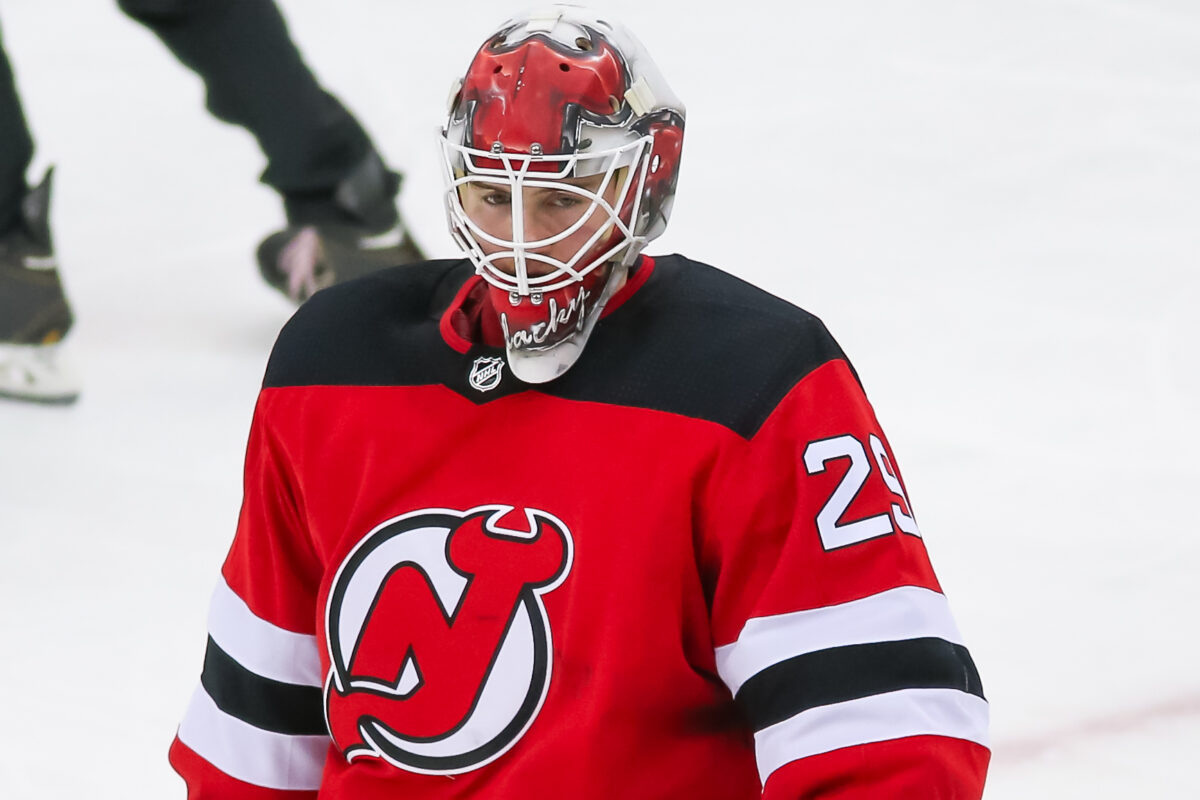The New Jersey Devils have not played well lately. They’re 2-12-2 in their last 16 games and have one win in April. That seems pretty terrible, right?
But the Devils have actually posted good results at five-on-five this month. Their Corsi-for percentage (CF%) of 55.5 percent ranks second-best in the league, while their expected goals percentage (xG%) of 57.2 percent is fourth-best. Even when adjusted for score effects, their CF% is 12th-best to go along with an xG% that is sixth-best.
Unfortunately, their goaltending has not held up its end of the bargain. In fact, it’s been downright terrible in April.
After last night’s loss to the Pittsburgh Penguins, the Devils’ save percentage (SV%) this month is .824. Forget about that not even being NHL-caliber; it’s not even AHL caliber. Let’s take a look at some of their numbers, assess what’s going wrong, and why the Devils’ defense doesn’t deserve all the blame in this instance.
Where It’s All Gone Wrong
Where do we start here? The Devils are having a topsy turvy season by all accounts, and the same is true of their goaltending. The team’s SV% until March 24th was .905, which was about league average, while their five-on-five save percentage was .925, ranked 10th-best in the league. So their goaltending was more than adequate and good enough to get by.
Fast forward to today, and it’s fallen off a steep, steep cliff. As mentioned, their SV% in April is .824, while their five-on-five SV% is .865. It’s probably not hard to guess those are both the worst marks in the league, and it’s not particularly close.
The Devils’ team defense has been a hot topic on social media. It hasn’t been great, but it doesn’t absolve their goaltenders of any blame. The Devils have an expected goals against of 29.9 this month but have allowed 56 actual goals. That’s good for a goals saved above expected (GSAx) of -26.1, meaning their goaltenders are not saving plenty of shots they should be saving.

The team’s goaltending struggles are not confined to one netminder either. Mackenzie Blackwood has an 0-6-1 record in April to go along with an .859 SV% and GSAx of -10.07. Scott Wedgewood has a .763 SV% in three games played and a GSAx of -6.24. Aaron Dell has played in four games but only has a SV% of .843 and GSAx of -6.62. The numbers aren’t any better at five-on-five, as all three goaltenders have a negative GSAx at that game state.
The biggest problem for the Devils’ goalies has been stopping high-danger chances. They’ve combined for a .694 SV% on high-danger chances at five-on-five, ranked the last in the league. For reference, it’s also last at all strengths (.654).
Related: Prospects News & Rumors: OHL, Binghamton Devils & Holtz
This is where the Devils’ defense comes into play. Yes, it hasn’t been great, but they’re giving up the third-least amount of high-danger chances per 60 minutes at all strengths and the least at five-on-five in April. The shot suppression has been there, even with the breakdowns. Some breakdowns have been brutal, but eventually, the team’s goalies have to bail out the miscues. Not every mistake should be ending up in the back of the net, but that’s the case right now. So what’s next? Well, for the time being, they may have to look to the AHL.
Senn Deserves a Shot in the NHL
The Devils have to address their goaltending woes this offseason. They gave it an upgrade when they signed Corey Crawford to a two-year deal, but he had a change of heart and decided to retire before the 2020-21 campaign began.
Fortunately, this summer’s free-agent class is quite deep and could include names such as Antti Raanta, James Reimer, Jaroslav Halak, and Chris Driedger, to name a few. It’d be a surprise if the Devils didn’t pursue one of those names or some of the other netminders who could be available.
There’ll come a time to go over those options, but none of those players can help right now. Blackwood will return from an injury sooner than later, but he still needs a backup. The Devils don’t have a ton of options in the AHL, but it may be time for them to give Gilles Senn, who’s been Binghamton’s starter, a chance in the NHL.

Senn has just a .894 SV% in the AHL, but I don’t think he’s been as bad as that number indicates. Binghamton has had even more defensive issues than New Jersey, and his numbers have taken a hit as a result. He’s faced 35 or more shots on goal in six of his 12 starts. That’s a lot of rubber to stop in a small sample size.
And for what it’s worth, Senn’s SV% has been a little better over his previous six starts, as it sits at .901. That’s not lighting the world on fire, but it’s miles better than what Dell and Wedgewood are providing right now. Plus, Senn has some NHL experience. He made a start against the Columbus Blue Jackets in Dec. 2019 and stopped 35 of 38 shots — a .921 SV%.
Related: 3 Takeaways From Devils’ Four-Game Series Against the Rangers
Senn measures 6-foot-5, 205 pounds, is athletic in net, and he passes the eye test on some nights when watching Binghamton. He’s 25 years old and will be a restricted free agent this summer. And with prospects like Nico Daws and Akira Schmid — who’s tearing up the USHL — on the way, it’d be smart of the Devils to see if they have anything in Senn.
At the very least, it’s hard to imagine Senn can be much worse than what the team is getting in between the pipes right now. It does benefit the Devils more to lose to strengthen their draft position, but they still need to be competitive. This is a young team comprised of almost all 20 to 25 years old. They can lose, but losing every game 5-1 or 6-1 because their goaltending is non-existent kills a team’s morale. That needs to change to end this season, and Senn seems like the best option to get that turned around as Blackwood’s backup.
* * *
Advanced stats from Natural Stat Trick